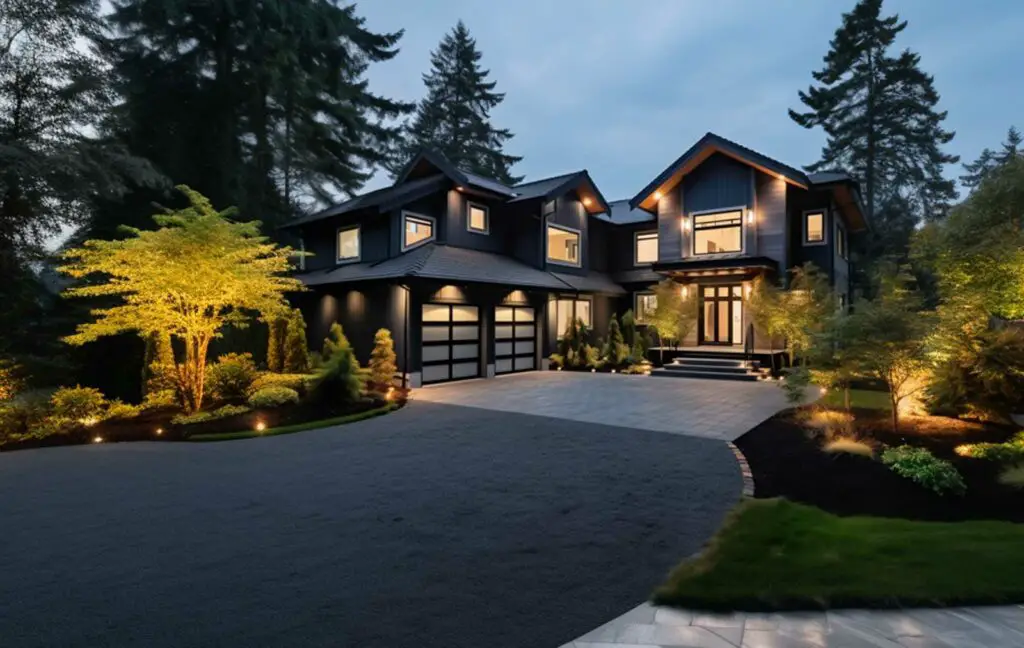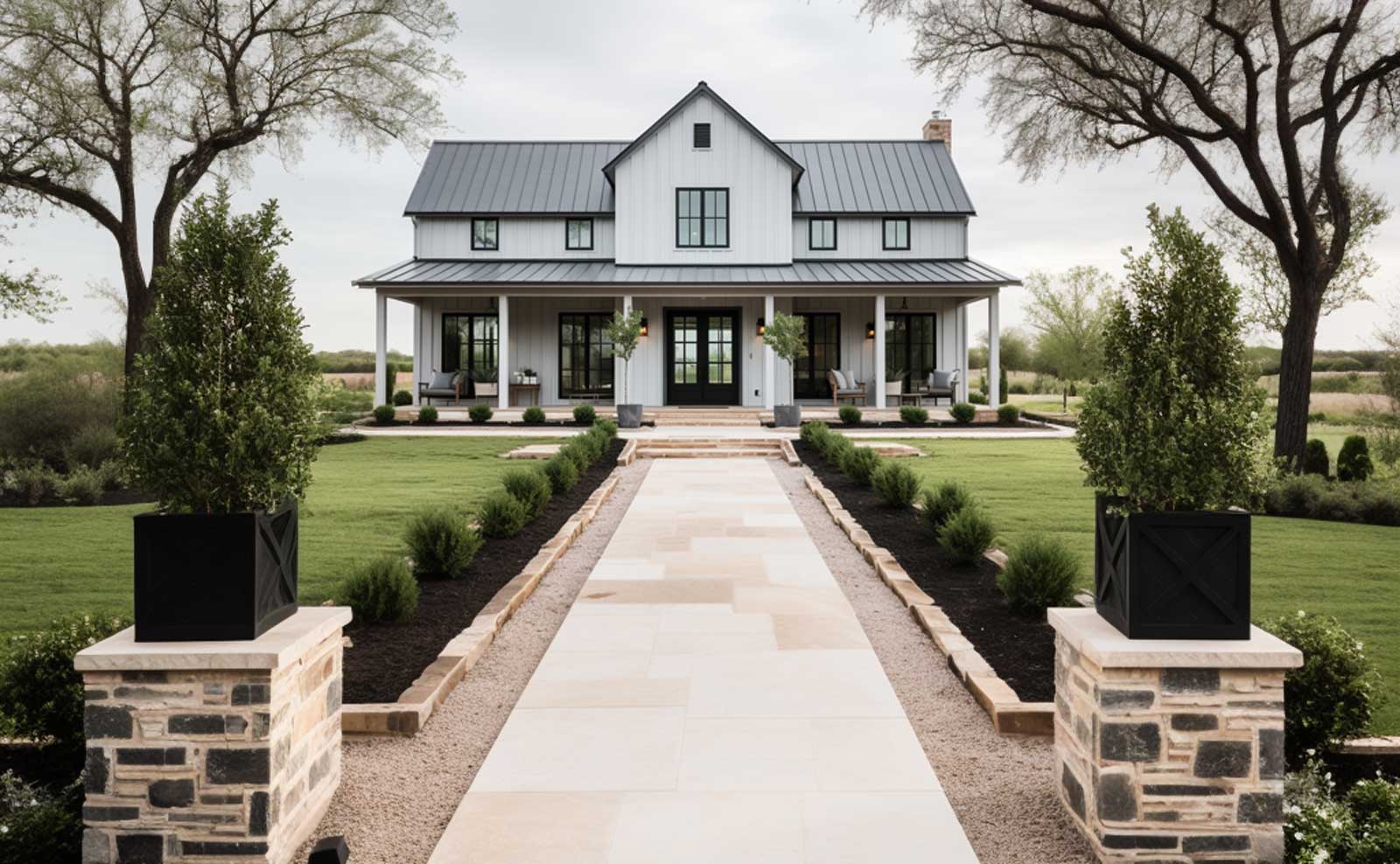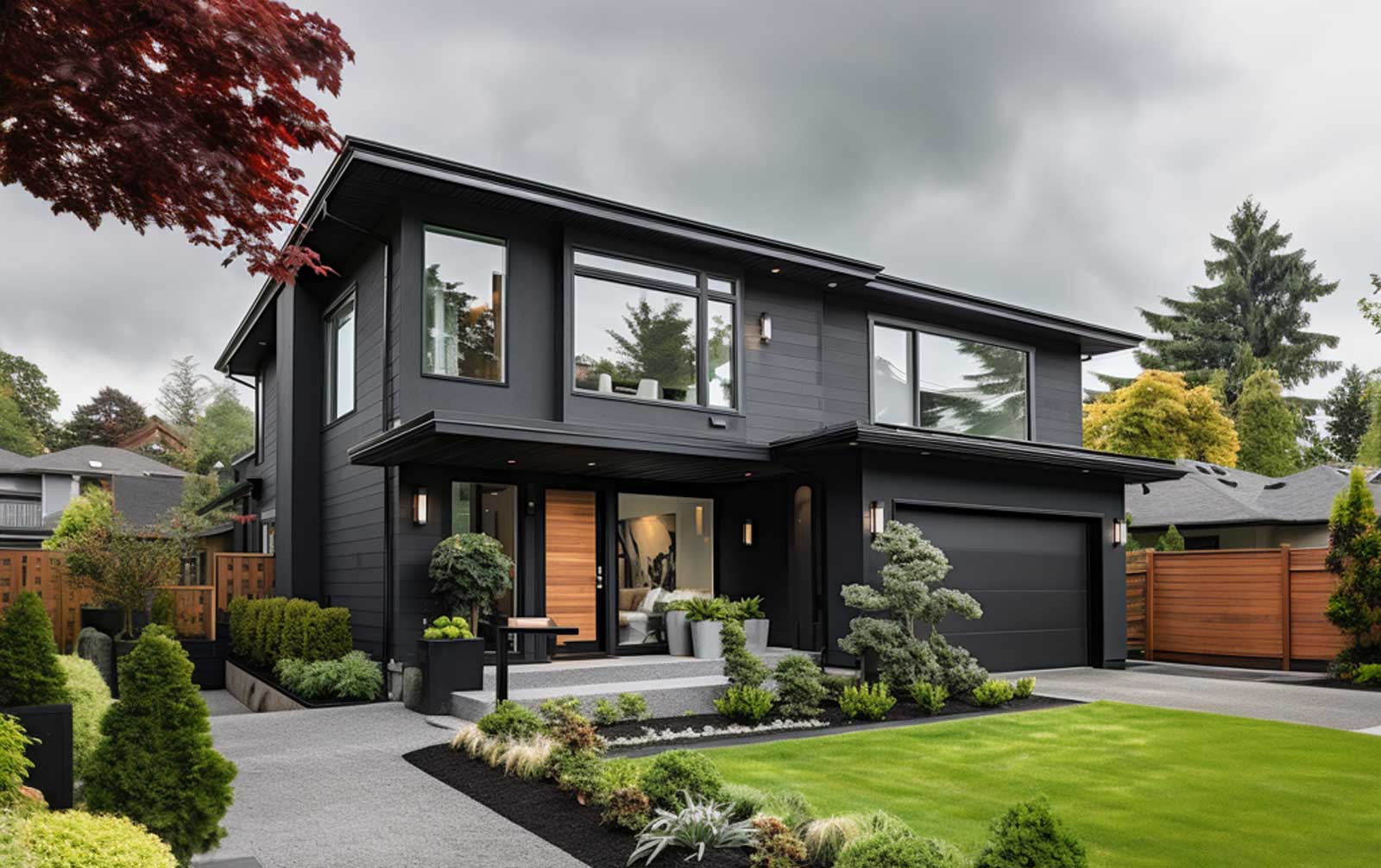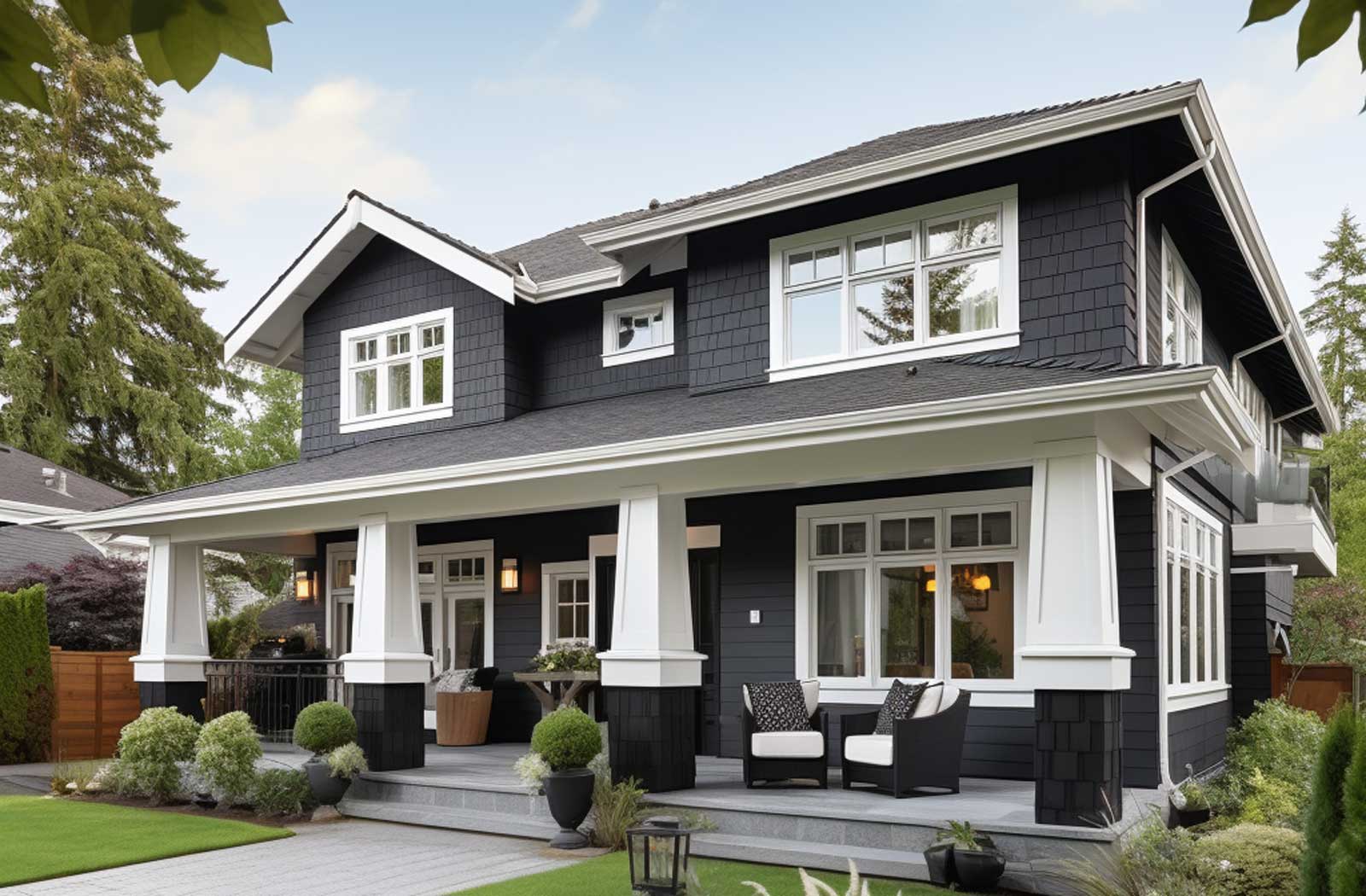Think gray is boring? Think again. This understated color can be the hero your home’s exterior has been waiting for. And we’re not just talking about a pretty facade – we’re about to spill the tea on how to leverage gray house paint and color schemes for jaw-dropping results.
You’ve got questions – we’ve got answers.
- What about blending grays and blacks for a modern look?
- What’s the perfect color combination for a light gray home?
- How does natural lighting affect your gray paint choice?
- And what about that ultimate question—what’s the best front door color for a gray house?
Don’t fret, we’ve got answers to all these and more.
So, whether you’re a DIY enthusiast ready for a weekend project or a seasoned real estate pro looking for a game-changing edge, fasten your tool belts. We’re diving deep into the transformative power of gray house paint and color schemes.
Color Scheme Ideas: A Palette for Every Home
You know it, I know it: the right color scheme can dramatically elevate your home’s curb appeal, almost like a swipe of the magic wand. Think about it, your house could be the next feature in an architectural digest, or, at the very least, your nosy neighbor’s topic of admiration.
The Monochromatic Gray Elevation: Not Just Another Shade of Dull
You think gray is boring? Think again. Gray is the Swiss Army knife of paint colors, versatile and eternally stylish. When applied in varying shades from light gray to dark grey, it creates a harmonious and sophisticated look that screams “modern look” louder than a car alarm at 2 a.m.
Monochromatic doesn’t mean monotonous. When it comes to home exterior, consider pairing dark grey siding with lighter window frames and white trim. The variety in darker and lighter shades adds focal points and visual interest to your facade. Want to elevate that even more? Go for a gray garage door to create a seamless, upscale look.
If you’re wondering what brands to choose, consider Sherwin Williams or Benjamin Moore. These titans of tint offer a range of grays that can bring a warm gray atmosphere or cool grays with blue undertones for a fresh look.
Insider Tip: For those a little afraid to commit, paint samples are your best friends. Test out various shades on smaller exterior elements like your mailbox or planters before going all in. It’s like dating before marriage but less expensive and emotionally taxing.
This isn’t theory; it’s personal. I once lived in a block where every other home was either a neutral color or a hodgepodge of conflicting shades. When I went full monochrome with grays, not only did my home become the focal point, but the curb appeal skyrocketed (and so did my ego, but let’s not talk about that).
So what’s the bottom line? A gray color palette is the fast track to a modern, harmonious look that is sure to turn heads and open wallets. Different shades of gray can offer everything from a warm, inviting exterior to a sleek, modern design. It’s not just a color; it’s an upgrade.
And remember: When it comes to your home’s exterior, a cleverly chosen color scheme is a game-changer.
The Yin-Yang Aesthetic: How Gray and White Elevate Timeless Sophistication
Picture this: You walk past a house and can’t help but stop to admire its harmonious facade. This house doesn’t scream for attention; it commands it. Welcome to the world of gray and white—a timeless classic that instantly refines the exterior of any home. So, are you ready to ditch the fads and go classic?
Why Gray and White are the Fred Astaire and Ginger Rogers of Home Exteriors
Yup, you heard that right. Gray and white go together like a suit and tie, offering a level of sophistication and class that’s just unbeatable. White trim against gray siding offers a crisp, clean look that appeals to a variety of home styles.
If your house were a person, consider white trim its impeccable bow tie or pearl necklace. In the world of paint colors, Benjamin Moore’s “Chantilly Lace” or Sherwin Williams’ “Pure White” could be your go-to white paints. These shades offer a stark contrast to a gray exterior, making every angle of your home a photo-worthy focal point.
But let’s not forget the main character here: Gray. Be it a cool gray with blue undertones or a darker gray for a more dramatic look, your home exterior will thank you. By the way, if you’re scratching your head over which shade of gray to pick, remember, paint samples are your allies, not enemies.
Let’s Talk Details:
- Window Frames: Go white for a crisp boundary that makes your windows pop.
- Garage Door: Match it with the gray siding or go slightly darker for depth.
- Roof Color: A gray roof complements the overall scheme, but feel free to experiment.
Play it Safe, But Don’t Be Basic
You might think that a gray and white color palette is a safe bet (and you’d be correct). However, it’s the small choices, like choosing the perfect shade or the trim color, that make a huge difference. And while ‘safe’ might sound like code for ‘dull,’ let’s just say in this case, it’s code for ‘you can’t go wrong.’
The Batman Effect: Gray with Black Accents for a Modern Fortress
Imagine this: You’re flicking through a glossy magazine or scrolling through Pinterest, and you suddenly freeze. Your eyes lock onto a home exterior that’s not just elegant; it’s daring. Let’s delve into the audacious yet refined world of gray with black accents, a design move that turns your home into a modern, edgy masterpiece. Are you buckled in?
From Zero to Hero: How Black Trim Transforms Gray Siding
Let’s set the stage. You’ve got that gray siding which you already love. It’s trendy, it’s versatile. But how do you elevate it from simply “in” to absolutely “it”? Black trim is the answer, and let me tell you, it’s like adding a smoky eye to a classic makeup look—striking yet incredibly sophisticated.
When it comes to black trim, your options are plentiful. Sherwin Williams’ “Tricorn Black” or Benjamin Moore’s “Iron Ore” could be your knight in shining armor, offering an edgy contrast to gray siding that screams curb appeal.
Consider These Key Points:
- Window Frames: Black trim frames your windows, adding stark contrast and visual interest.
- Garage Door: Go bold and match the garage door with the black trim for a cohesive, modern look.
- Front Door: If you want to go the extra mile, a black door creates an intriguing focal point.
Colors & Your Modern Home: It’s a Match!
The gray and black color combination is particularly compelling for modern homes. The lines are clean, the color palette is minimal, and the overall exterior design echoes contemporary aesthetics. In a world where everyone is painting their homes neutral tones or bright colors, opting for a dark gray home with black accents sets you apart in the best way.
Making Waves: Transform Your Home with Coastal Blues and Grays
Picture this: You’re walking along the beach, the ocean breeze in your hair, and you see it—the perfect coastal home, where soft blues meet calming grays. You think, “That could be my home!” But can you bring the beach to your doorstep without having to relocate to Malibu? Buckle up, because we’re taking a deep dive into how to master that coastal feel with the right color palette for your home exterior.
The New Nautical: Soft Blues for a Tranquil Exterior
Ever think you could capture the essence of the ocean with a brushstroke? Well, that’s the magic of soft blues. These hues don’t just remind you of the beach; they are the beach. Whether it’s Sherwin Williams’ “Rain” or Benjamin Moore’s “Sea Glass,” the right soft blue paint can transform your home exterior from bland to grand, adding a layer of sophistication that’s perfect for a coastal feel.
If you want a focal point that subtly grabs attention, consider a soft blue front door. It’s a fresh look that adds visual interest without screaming for it. A good example? A navy blue door with lighter blue undertones would make a perfect entryway accent, setting a tranquil tone for the rest of your home.
Pro Tip: Keep it Classy
- Accent Colors: Soft blue accents on window frames or the garage door can unify your exterior elements.
- Trim Color: Go with white trim to complement both gray siding and blue accents, making your home’s exterior look crisp and inviting.
The Perfect Marriage: Why Gray and Soft Blues are a Match Made in Coastal Heaven
The strength of gray as a base color for your home is its versatility. Light gray works incredibly well with soft blues, offering a neutral backdrop that lets those blues shine. You’re not just picking a trendy color combination; you’re setting a mood that resonates with everyone who passes by. The key takeaway here? Coastal is not just a look; it’s a feeling.
Choose Wisely: Make Your Coastal Vision Come to Life
- Gray Siding: Opt for a light gray for a fresh, neutral base.
- Soft Blue Accents: Perfect for the front door, window frames, and even the garage door.
- White Trim: Complete the look with white trim for that perfect coastal crispness.
Back to Nature: Unearth the Secrets of Earthy Gray Exteriors
Ever stared at your home’s exterior and thought, “If only it could channel the beauty of a mountain retreat or a forest cabin!” The good news? You don’t need to move to the Rockies to get that earthy vibe. Let’s talk about how an earthy gray color palette, combined with the right shades of browns and greens, can bring that nature-inspired serenity right to your doorstep.
Mother Nature’s Canvas: The Magic of Earthy Gray
Ever notice how nature has the ultimate color palette? The grays of pebbles, the browns of tree bark, the greens of foliage—it’s all there, just waiting to inspire your home’s exterior design. Imagine bringing those colors home, not just in your hiking boots but on your walls. Sherwin Williams’ “Alpaca” or Benjamin Moore’s “Revere Pewter” offer that perfect earthy gray base color that’s as inviting as a forest path.
Let’s talk trim color. You don’t want your gray siding to get lost in the woods, so make sure you’ve got the right accents. Brown trim offers a cozy contrast that’s as natural as it gets. Got a brick house? Even better. The earthy gray and brown combo will blend seamlessly with natural elements like gray stone or even a brown roof.
Going Green: Add the Final Touch to Your Earthy Palette
The last piece of this tranquil puzzle is green. And no, we’re not talking the color of envy (although your neighbors might get a little jealous). Green undertones in your earthy gray or selective green accents can truly make the exterior of your home resonate with nature’s splendor.
So, what’s the best way to add green? Consider your garage door or even your window frames. If you have stone columns, a hint of green can bring out their natural qualities. Your focal point, such as the front door, is another opportunity to bring in green for that final, cohesive touch.
Get the Green Light: Your Earthy Palette Checklist
- Earthy Gray Base Color: Consider lighter colors with green undertones.
- Brown Accents: Perfect for the trim and for blending with natural elements.
- Green Highlights: Consider the garage door, window frames, and front door as potential candidates.
The Swiss Army Knife of Exteriors: Mastering Neutral Tones
Picture this: You’re standing in the paint aisle, staring at paint samples, and your eyes glaze over. Reds too bold, blues too moody. You need something versatile, something timeless. Enter the world of neutral tones—specifically the underrated team-up of gray and beige. Let’s dive into why this color scheme is the Swiss Army knife of exterior design.
The Power Couple: Gray Meets Beige
Let’s not mince words: Gray and beige are the Batman and Robin of neutral tones. Individually, they’re strong. Together, they’re unstoppable. If you want your home exterior to feel modern yet timeless, you can’t go wrong with this dynamic duo.
Start with a gray siding. A warm gray gives a softer look, while a cool gray, think Sherwin Williams’ “Passive”, offers a crisp, modern look. Now, what complements gray better than beige? For trim color, beige works like a charm. You could go for Benjamin Moore’s “Shaker Beige” for a smooth finish. The color combination of gray and beige brings in a visual interest that keeps your exterior from being a snooze fest.
Sprinkle in Some White: The Final Touch
Gray is good. Beige is great. But to truly unlock the magic of neutral tones, consider white trim. It’s like adding a little cream to your coffee or a touch of vanilla to a cake recipe—it’s that extra something that completes the look.
Let’s get specific. Your garage door and window frames are prime candidates for the white treatment. They become the focal point against the gray and beige background. If you’re feeling adventurous, a white exterior element like stone columns could also work as a striking contrast.
Your Neutral Tones Action Plan:
- Choose Your Base: Warm gray or cool gray.
- Add the Trim: Go with beige for a soft, inviting look.
- Accent with White: Window frames and garage door are perfect choices.
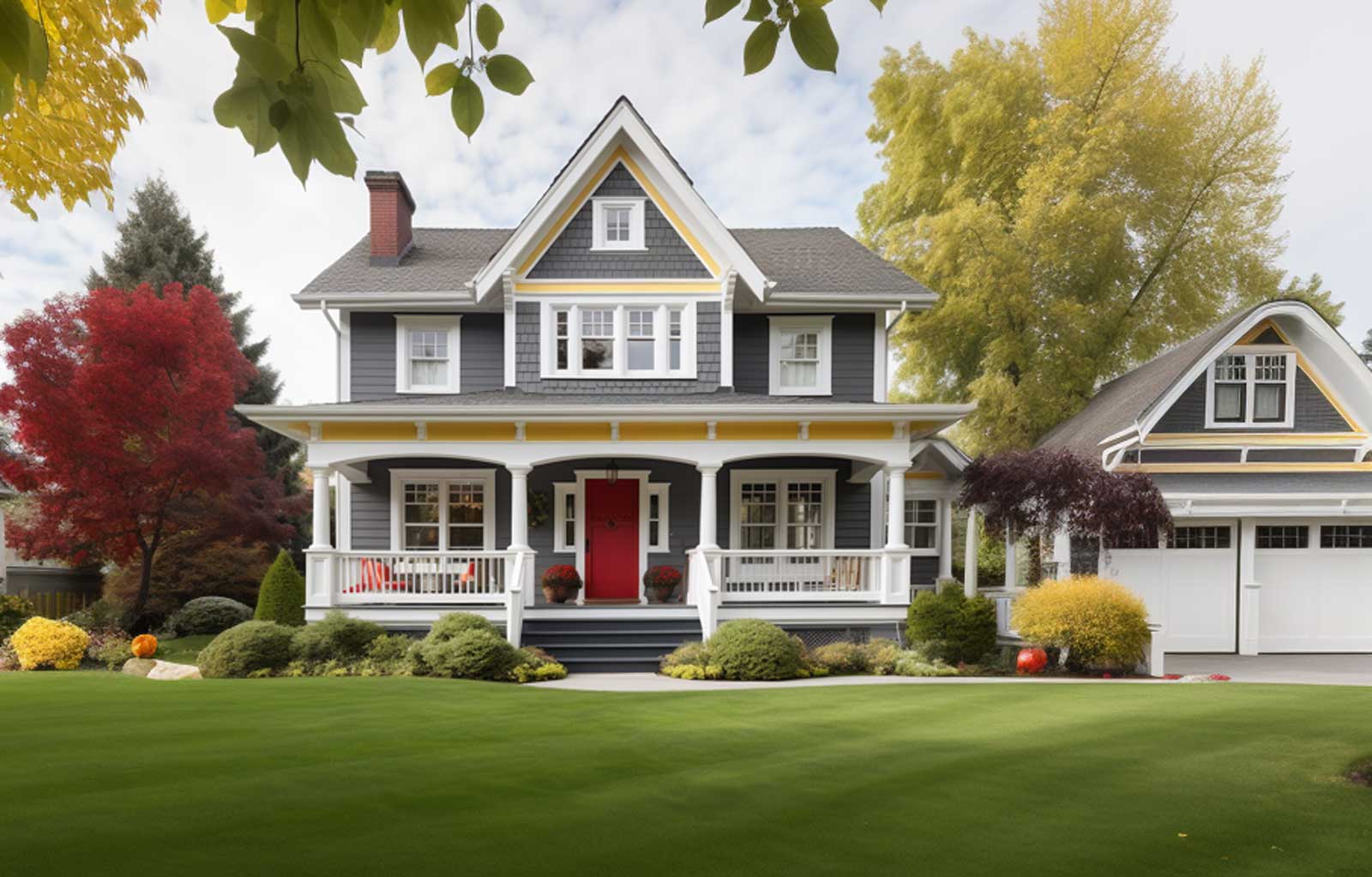
Color That Packs a Punch: The Art of the Pop
Imagine your home exterior as a classic film. It’s well-directed, timeless, but let’s face it, it’s in black and white. Now, imagine injecting a burst of Technicolor right where it matters. Welcome to the next level: using gray as a base color with a bright color accent like red or yellow. Let’s pull back the curtain on this scene-stealing approach.
The Timeless Canvas: Gray All the Way
Think of gray as the Meryl Streep of paint colors—always in style, infinitely versatile. Whether you’re rocking a modern home or something more traditional, gray provides a solid base. From lighter shades like Sherwin Williams’ “Agreeable Gray” to darker shades that edge toward slate, your choices are anything but limited.
In fact, gray siding provides a neutral backdrop that lets you play with various accents. Think of it as your stage setting, every great performance needs one. My neighbors once doused their home in vibrant blue. It was eye-catching, for sure, but when it came time to sell, it was a different story. On the other hand, my gray exterior was not just a hit, but it allowed for more creative liberties with the details.
The Showstoppers: Red and Yellow Accents
Who said gray had to be boring? You know what wakes up a gray exterior faster than a double espresso? A pop of color. Red and yellow accents are the caffeine in this equation.
For the best front door color, look no further than a bright red or sunny yellow. Or consider a bright red door. It’s like putting red lipstick on a monochrome outfit—suddenly, everyone’s looking. These colors work as a focal point, drawing the eye towards your entrance. If a bright door isn’t your jam, how about yellow window frames? They add the same punch without dominating the visual landscape.
Your Pop of Color Cheat Sheet:
- Start with Gray: From light to dark, it’s your ideal base.
- Door Drama: Red or yellow for instant curb appeal.
- Subtle Touches: Consider window frames for less-in-your-face flair.
Retro Radiance: Marrying Gray with Pastels for That Vintage Vibe
You’ve got a gray exterior, and it’s as stylish as a well-tailored suit. But what if I told you there’s a way to crank up the charm to Cary Grant levels? Hang on to your fedoras, folks; we’re going to jazz up that gray exterior with pastel colors like pink and mint for a look that’s as timeless as it is unique.
Class Meets Whimsy: Gray as Your Classic Foundation
Hold up! Before we go splashing color like it’s Easter Sunday, let’s appreciate what gray brings to the table. It’s the canvas on which you’re going to paint your masterpiece. A color that can pull off anything—like that one friend who looks good in literally anything (jealous, much?).
Your gray siding or paint can range from cool grays with blue undertones to warm grays with a touch of brown. The point is: gray serves as a steady base for the palette party you’re about to throw.
Sweet Accents: Say Hello to Pink and Mint
Ready for the twist? You’re adding pastels. Pink and mint, to be exact. These colors don’t just shout “Spring Break!” They offer a delightful contrast to the stoic, distinguished gray. A perfect balance if you’re looking to break from the modern, all-business look.
Remember those iconic diners from the ’50s with their pastel interiors and checkered floors? Imagine channeling that vibe but in an exterior setting. You can introduce pink or mint in several ways, be it your trim color, window frames, or even a stylish garage door. An old buddy of mine tried this on his Craftsman-style home; let me tell you, that was one photogenic house!
How to Add Pastels Without Overdoing It:
- Pick One: Either pink or mint will do. No need to start a pastel parade.
- Accentuate: Use your chosen pastel for smaller, more focused areas like the trim or door.
- Samples, Please: Test out paint samples before committing. Pastels can be tricky!
Proof in the Palette: Top Pastel Picks
Alright, you’re probably asking, “Which pastel should I go for?” Brands like Sherwin Williams and Benjamin Moore offer an array of options. For mint, think “Sea Foam” or “Pale Green Tea.” For pink, a muted “Rosy Outlook” or “Petal Pink” are both excellent options. These aren’t your little sister’s bedroom colors; these are mature, sophisticated shades that add vintage charm while preserving your home’s architectural integrity.
The New Classic: Go Modern Minimalist with Light Gray, White, and Black
So, you want your home to be the talk of the block. You’re looking for a “wow” factor that marries sleek lines with emotional depth. Buckle up, because we’re diving into the modern minimalist approach—where less truly is more, and your home will become the envy of any modern-art aficionado.
Shades of Simplicity: Why Light Gray is Your New Best Friend
No need to panic, but gray is not just gray. The game-changer for modern minimalists? Light gray. Imagine the smooth lines of modern homes enhanced by the subtle sophistication of light gray siding. The best part is, this color pairs impeccably with both whites and blacks, making it the Swiss Army knife of exterior color schemes.
Light gray sidings are not only versatile; they’re also a visual treat. And with cool grays or warm grays (with zero to minimal green undertones), you have options. So go on, swatch it out—Sherwin Williams and Benjamin Moore have a sea of light gray paint samples just waiting for you.
Trimming the Fat: Pairing Light Gray with Whites and Blacks
When you’re already working with a neutral like light gray, it’s almost a sin not to play up the accents. Let’s talk trim color. Whether you opt for white trim or black trim, you’re setting the tone—literally—for the entire exterior of your home.
- White Trim: Gives your home exterior a fresh, open look, and serves as a perfect contrast to light gray. Think “pure white” for an immediate lift.
- Black Trim: Offers a more grounded, serious tone. Brands like Tricorn Black provide a stark contrast that screams “this house means business.”
Remember, your trim is the frame of your architectural masterpiece. Don’t mess it up.
The Doorway to Minimalism: Perfecting the Color Combo
You thought we were done? Not even close. The cherry on top, or should I say, the door on the house, is where you solidify your modern minimalist look. Picture this: a black door. Sure, it’s not as welcoming as a plate of chocolate chip cookies, but it is an immediate focal point that provides a ton of curb appeal.
If you’re skeptical about a black door, go with a darker shade of gray. No, it’s not taking the easy way out; it’s called being harmoniously selective.
A Final Nod: Roof and Window Frames
Ah, the final touches. Your roof color and window frames are like the garnish on a five-star meal. A gray roof complements the light gray exterior, tying everything together. As for the window frames, black offers a touch of modernity, while white provides a smoother transition between the elements.
To cap it off, the modern minimalist approach works well with a variety of home styles. It’s not just for the uber-modern abodes; even traditional houses can pull off this sophisticated look.
Striking Visuals: The Art of High-Contrast in Home Exteriors
You’re the type who lives for drama. But not the kind you see on reality TV—no, you’re after something a bit more… permanent. Feast your eyes on high-contrast home exteriors where gray, black, and white mingle for a design that packs a punch.
The Power Trio: Gray, Black, and White
Why settle for a monotone facade when you can have a symphony of color? High-contrast exterior schemes using gray, black, and white provide more than just curb appeal—they offer a visual feast. Yes, we’re talking a color palette that’s as captivating as a cliffhanger in your favorite Netflix series.
Gray siding serves as the base color, setting a neutral yet inviting stage. Then, cue the drama with black and white as your accent colors. These elements, whether they’re trim color or window frames, punctuate the gray, acting as bold focal points that command attention.
Define the Lines: Black and White Trims
Time to zero in on the details. Your trim color has a job—establishing the boundaries, the “do not cross” lines, if you will, of your home’s exterior. Black trim brings a level of sophistication and gravity that balances the light gray siding. It’s the espresso shot in your vanilla latte. On the flip side, white trim creates a clean line that lets your home breathe, amplifying the gray color. It’s the creamer in your coffee, smooth and enriching.
- Black Trim: Best for modern homes wanting a sleek, contemporary feel.
- White Trim: Ideal for homes looking for a timeless look with a dash of elegance.
Doors and Roofs: Final Touches for Maximum Impact
Listen up! Your front door and roof aren’t just functional elements; they’re part of the grand performance. A black door can be an eye-popping focal point that says, “Hey, look at me!” Benjamin Moore and Sherwin Williams offer deep blacks that work well in these high-contrast schemes.
And let’s not overlook the roof. A gray roof or even black roofs can add another layer to your high-contrast exterior, giving it depth and visual interest. Trust me, your neighbors will be green with envy (not that you’re using green, of course).
Rule of Three: Why This Scheme Works for Any Home Style
Get this: the high-contrast trio of gray, black, and white works across a variety of home styles. From modern houses with their clean lines to classic homes wanting a fresh look, this exterior design concept is as versatile as a Swiss army knife.
- Modern Homes: Go for darker shades of gray with black trim for a modern look with stark contrast.
- Classic Homes: Opt for light gray with white trim, adding black as an accent for a timeless yet dynamic appearance.
The Seasonal Shift: Keep Your Home’s Exterior Fresh All Year Long
Let’s be honest: nobody wears the same outfit every day. So why should your house? Imagine your home’s exterior getting a seasonal wardrobe that keeps it looking runway-ready all year long. Strap in, because we’re diving into how gray can pair brilliantly with seasonal colors for a perpetually fresh look.
The Four Seasons of Your Home’s Exterior
Mother Nature changes her look every few months, and so can you. Pairing gray, a neutral color that’s essentially the denim of home exteriors, with seasonal accent colors can make a massive impact. Seriously, it’s like your house is having a fashion show and every season is a different runway theme.
- Spring: Think pastel accent colors. Light pinks, blues, and greens can add a subtle burst of life against a gray backdrop.
- Summer: Brighten up with some bold colors. Think about sherwin williams trending colors like canary yellows or fiery reds to really sizzle.
- Autumn: Time to go cozy. Opt for warm tones like burnt orange and earthy browns to bring out the warm gray in your exterior paint.
- Winter: Go for stark contrast. Whites and navy blues create a crisp, clean look that complements the frosty weather.
Seasonal Accents: Where to Pop That Color
Now that you’ve got your seasonal color palette dialed in, let’s talk placement. Where you put these accent colors can make a huge difference. So listen up!
Window frames, garage doors, and trim color are all excellent spots for your seasonal colors. These are the places where a pop of color can function like a well-placed accessory—adding a dash of excitement without overwhelming the whole outfit.
But What About the Front Door?
Ah, the pièce de résistance! Your front door is like the statement necklace of your home’s exterior. Changing up the front door color seasonally is not just a good idea; it’s a game-changer. Benjamin Moore and Sherwin Williams offer paint samples in a range of trending and classic colors, perfect for your seasonal whims.
Imagine a bright red door for summer that shifts to a warm pumpkin spice hue in the fall. Each season brings its own focal point to your exterior design, keeping the look fresh and inviting.
Master the Swap: Tips for Easy Seasonal Changes
Nobody’s got time for a lengthy home makeover four times a year. But here’s the best part: you don’t need a complete overhaul. Simple changes can deliver a fresh look without a massive effort.
- Use High-Quality Paint: This means fewer coats and a quicker application process.
- Plan Ahead: Select your seasonal colors in advance and schedule the changes like you’d schedule a haircut—regular and planned.
